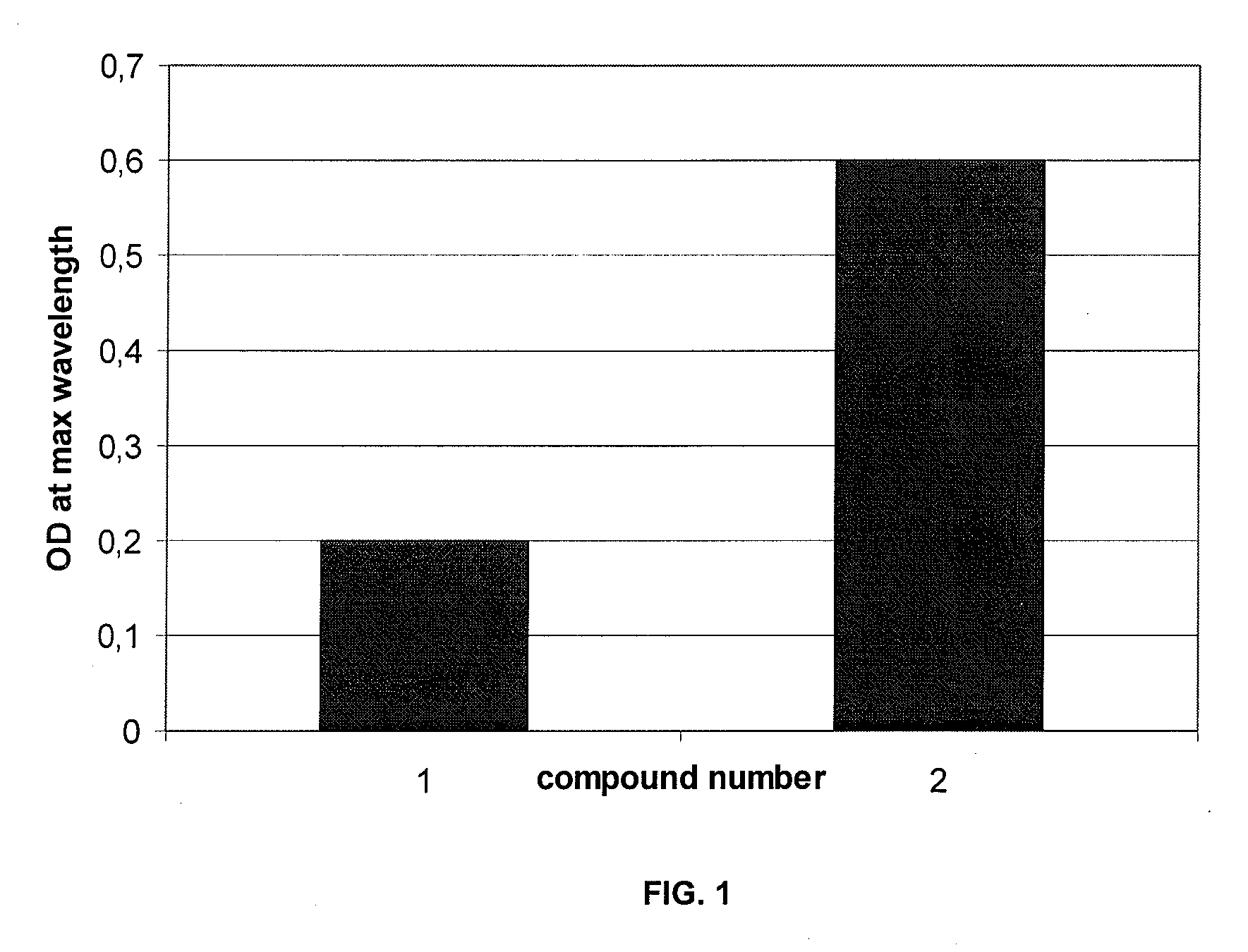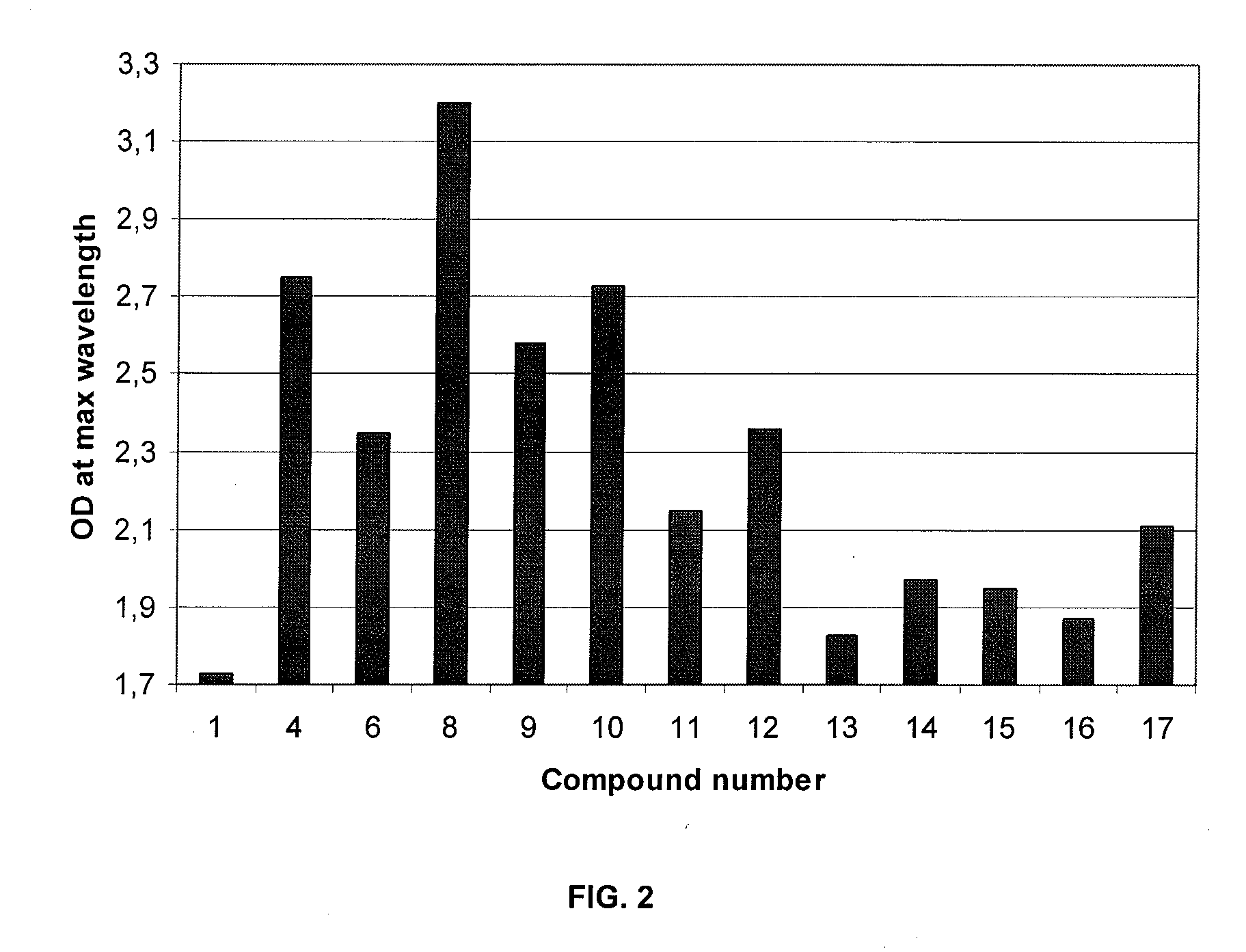Azo dyes
a technology of azo dyes and dyes, applied in the field of new azo dyes, can solve the problems of high effluent color, high toxicity of traditional azo dyes, and low ecotoxicity of traditional azo dyes, and achieve low cytoxicity and ecotoxicity, and good optical density.
- Summary
- Abstract
- Description
- Claims
- Application Information
AI Technical Summary
Benefits of technology
Problems solved by technology
Method used
Image
Examples
example 1
Synthesis of Compounds of Formula (I) or (II)
[0190]Compounds of Formula (I) or (II) may be prepared according to any of the protocol N to T.
[0191]The compounds may be produced by the reaction of two precursors listed in Table 1 or by the reaction of a precursor listed in Table 1 with a precursor listed in Table 2. Said reaction is preferably performed in the presence of enzymes, in particular oxidoreductase enzyme. Suitable oxidoreductase used for the preparation process can be selected from the group consisting of laccases, peroxidases, cellobiose deshydrogenases and tyrosinases, and preferably laccases.
[0192]Unless indicated otherwise, All reagents used were either obtained commercially or were prepared in a manner known per se.
[0193]Unless indicated otherwise, the enzyme activity was determined according to protocols A or B.
[0194]Protocol A:
[0195]Laccase activity was determined by oxidation of ABTS [2′,2-azino-bis-(3-ethylbenzo thiazoline-6-sulfonic acid)] (4 mM) (Sigma-Aldrich) ...
example 2
Comparison of Some Characteristics of the Compounds According to the Invention
[0269]Table 4 shows some characteristics of compounds in their reaction medium.
TABLE 4DO at λmaxDyeColorλmax (nm)1*2**3***Compound 1burgundy5000.281.73Compound 2violet5500.6Compound 3fuchsia5000.2Compound 4fuchsia5452.75Compound 6fuchsia5402.35Compound 8fuchsia / burgundy4703.205502.85Compound 9violet5552.58Compound 10violet5502.73Compound 11fuchsia5252.15Compound 12fuchsia5402.36Compound 13violet5201.83Compound 14fuchsia5301.97Compound 15fuchsia5251.95Compound 16mauve5151.871* synthesis following protocol N2** synthesis following the protocol R3** synthesis following the protocol O
[0270]FIG. 1 shows the optical density measured at maximum wavelength for some compounds of the invention (in the reaction medium) prepared according to protocol N.
[0271]FIG. 2 shows the optical density measured at maximum wavelength for some compounds of the invention (in the reaction medium) prepared according to protocol O.
examples 3
Results of Dyeing With Compound 1, Compound 2 and Compound 4
[0272]Polyamide knitted fabric dyeing—Knitted polyamide 6 was immersed in a dye bath at 40° C., containing the dye solution (0.21%, 0.42%, 2.5% omf), Setacid VS-N (buffering agent—2 g L−1) and Setalan PM-8 (leveling agent—1 g L−1). The liquor ratio was 20 / 1. The pH was adjusted to 6.5 to 7.5 by adding sodium bicarbonate (0.2-0.3 g L−1). The temperature was raised to 105° C. over 40 min. The dyeing was continued at 105° C. for 40 min. The final pH of the dyebath was between 4.2 and 4.3. The dyed pieces were there rinsed twice at 40 and 25° C. for 5 min (liquor ratio 20 / 1). Fabrics dyed using 2.5% on mass of fabric (omf) were used for fastness tests as their depth corresponded to the standard depth scale as published by the society of dyers and colorists.
[0273]Shade was characterized by reflectance measurements with DataColor SF600 spectrophotometer with 10 nm band width using U.V. excluded and specular included measurements...
PUM
| Property | Measurement | Unit |
|---|---|---|
| optical density | aaaaa | aaaaa |
| optical density | aaaaa | aaaaa |
| temperature | aaaaa | aaaaa |
Abstract
Description
Claims
Application Information
 Login to View More
Login to View More - R&D
- Intellectual Property
- Life Sciences
- Materials
- Tech Scout
- Unparalleled Data Quality
- Higher Quality Content
- 60% Fewer Hallucinations
Browse by: Latest US Patents, China's latest patents, Technical Efficacy Thesaurus, Application Domain, Technology Topic, Popular Technical Reports.
© 2025 PatSnap. All rights reserved.Legal|Privacy policy|Modern Slavery Act Transparency Statement|Sitemap|About US| Contact US: help@patsnap.com



